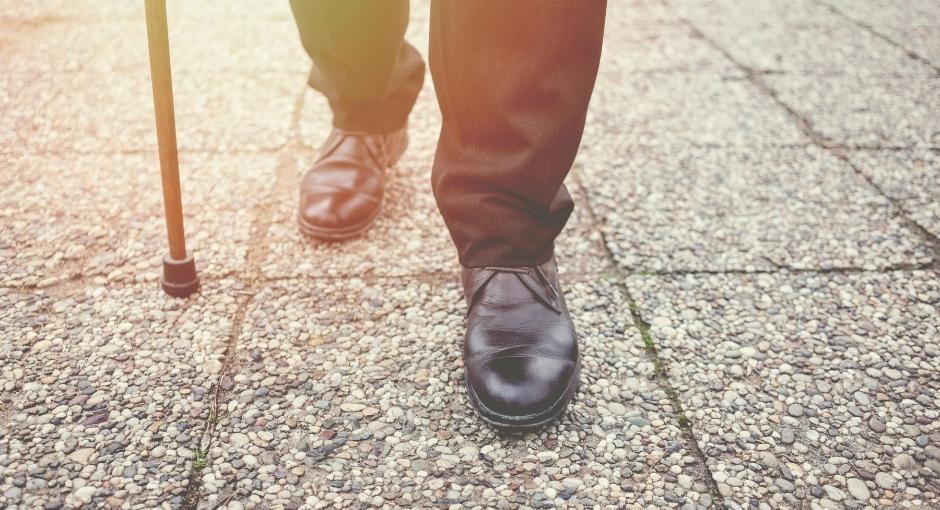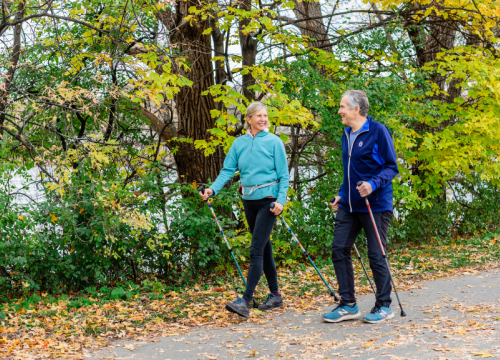Trouble Moving or Walking
💡 Quick Summary
-
Parkinson’s disease affects walking, balance and coordination, leading to shuffling, smaller steps, slower pace, reduced arm swing and difficulty turning.
-
Movement and sensory changes in PD cause bradykinesia (slowness), hypokinesia (small movements) and trouble starting, stopping or linking movements.
-
Freezing of gait — a temporary inability to move — can occur when walking, turning or in doorways.
-
Freezing increases risk of falling.
-
Tips for improving walking include adjusting posture, using visual cues and practicing safe turning techniques.

People without Parkinson's disease (PD) do not often think about walking. Their arms swing naturally and their feet land on the heels with each step. They can walk and talk and carry bags, purses and plates of food, often without difficulty.
For people with PD, walking becomes less automatic. As Parkinson’s progresses issues can develop, such as problems with walking (gait abnormalities), poor balance (postural instability) and feeling like their legs are heavy or dragging. Feet begin to shuffle and multitasking becomes more difficult. Additionally, turning around can be tricky — sometimes leading to freezing or falls.
Movement and Sensory Changes
People with PD have trouble regulating the speed and/or size of their movements. Movements are bradykinetic (too slow) or hypokinetic (too small).
Movement System Changes
These changes can lead to challenges controlling movements, including:
- Starting and stopping movements
- Automatically controlling muscles
- Linking different movements to accomplish one task (e.g., moving from sitting to standing)
- Finishing one movement before beginning the next (e.g., not completely turning around before sitting down)
Sensory System Changes
These changes can lead to challenges, particularly noticing and correcting movement and voice issues, including:
- Slowness or smallness of movements (e.g., when told to make the movement bigger, a person with PD may feel the movement is now “too big”)
- Lack of movement (e.g., an arm that does not swing during walking)
- Changes in posture
- Changes in voice volume (e.g., when told to speak louder, a person with Parkinson's may feel they are shouting)
Walking Changes
Parkinson’s disease can change how a person walks. Slow movement, stiffness and rigidity make walking normally harder. There are many PD-related walking changes:
- Smaller steps
- Slower speed
- Less trunk movement (especially rotation)
- A narrow base of support (feet too close together)
- Less or absent arm swing (on one side of the body or both)
- Trouble turning
- The feet land flat on the floor with each step instead of on the heel (can lead to shuffling and falls)
- Heavy or dragging legs (feeling like legs are too stiff or weighted to lift easily)
- Festination or shuffling (quick, small, involuntary steps forward; often accompanied by stooped posture)
- Retropulsion (quick, small, involuntary steps backward)
Freezing
Some people experience “freezing,” the temporary, involuntary inability to move. This can occur at any time, though it tends to occur when initiating a step, turning or navigating through doorways. It can be a serious problem, as it may increase risk of falling.
Page reviewed by Dr. Kathryn P Moore, Movement Disorders neurologist at Duke Health, a Parkinson's Foundation Center of Excellence.
Related Materials
Expert Briefing: Freezing or Sweating Falls When Walking
Exercise and PD
Related Blog Posts

Walking with Parkinson’s: Freezing, Balance and Falls

New Exercise Recommendations for the Parkinson’s Community and Exercise Professionals
